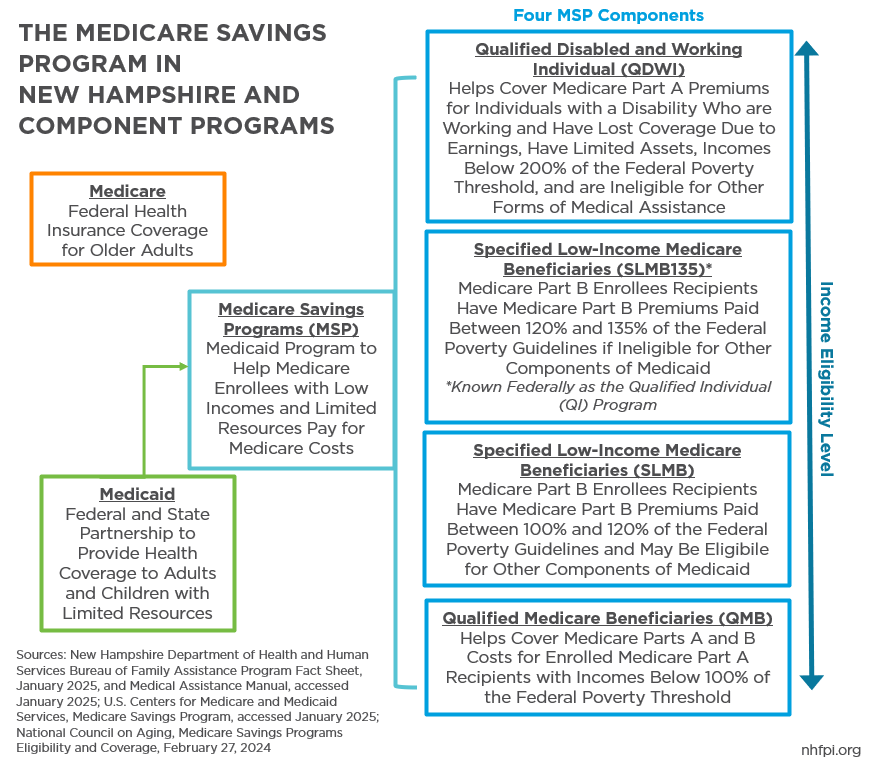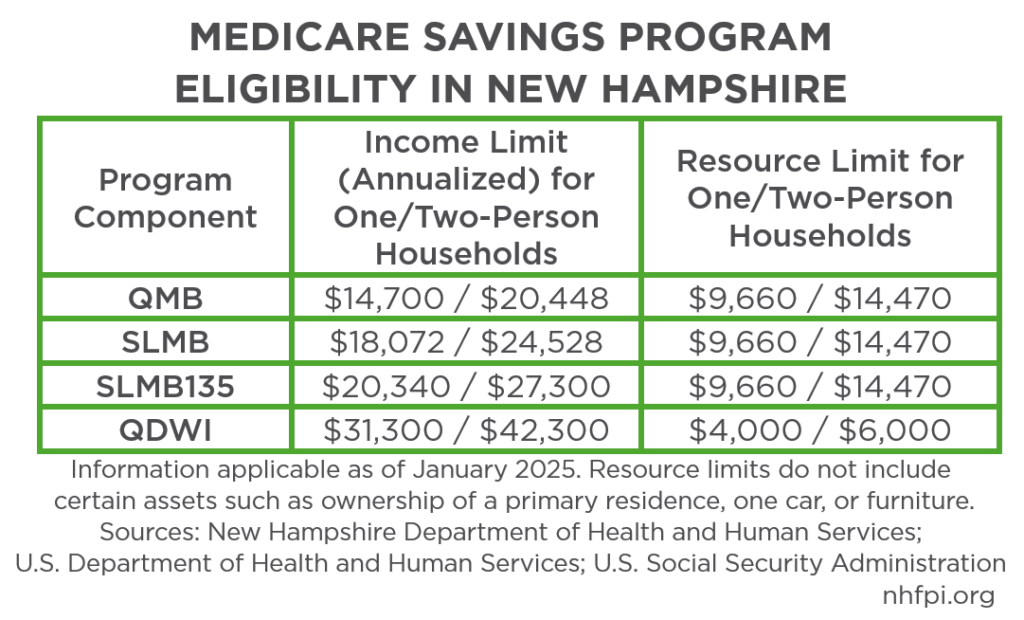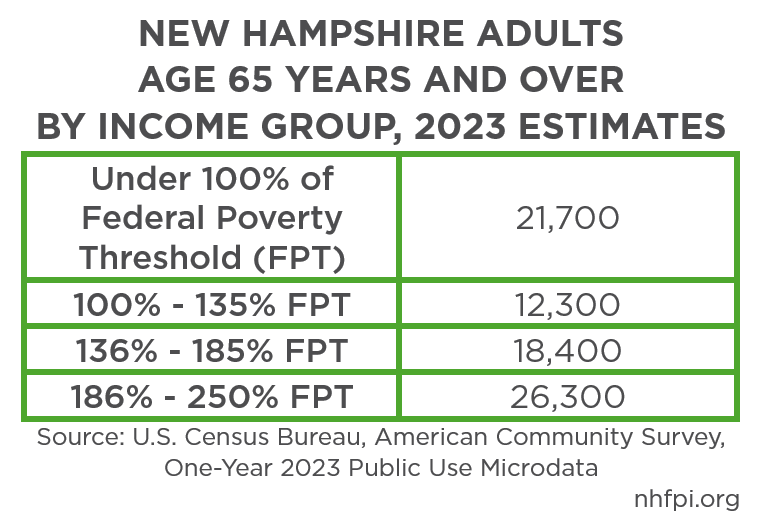Medicare is a federal program that provides health coverage for individuals age 65 and older, and for younger people with certain disabilities or health conditions. Medicare has plan options, some of which require premium payments, and eligible enrollees can select among those options. Enrollees may also buy supplementary private coverage; in 2023, approximately 13.8 percent of New Hampshire’s population had a combination of Medicare and another coverage plan.1
For certain services, such as long-term care, older adults may also be eligible for Medicaid. Medicaid is a fiscal partnership between the federal government and the states designed to support the health of people with low incomes, limited assets, or certain disabilities or health conditions. Medicaid can be used by states to help Medicare enrollees pay for certain Medicare Part A (hospital insurance) and Part B (medical insurance including outpatient, equipment, and preventative services) premiums, deductibles, coinsurance, or copayments. Medicaid coverage to help with these Medicare expenses for eligible residents is provided through the Medicare Savings Program (MSP).2
New Hampshire’s MSP is comprised of four different component programs, and each have different levels of income and asset-based eligibility. The programs within MSP are:
- Qualified Disabled and Working Individual (QDWI)
- Qualified Medicare Beneficiaries (QMB)
- Specified Low-Income Medicare Beneficiaries (SLMB) for incomes from 100 to 120 percent of the federal poverty guidelines
- Specified Low-Income Medicare Beneficiaries (SLMB135) for incomes from 120 to 135 percent of the federal poverty guidelines (also called “Qualified Individuals” federally)
Asset tests include key resources, such as bank accounts and retirement savings, but exclude certain assets, including a home, one car, and furniture.3
Enrollment and Expansion Options
At the end of 2024, the New Hampshire Department of Health and Human Services reported 9,800 MSP enrollees who were age 65 and over.4 About 34,000 Granite Staters age 65 and over had incomes below 135 percent of the federal poverty threshold in 2023, but detailed information about assets is not available.5 One quarter of households in New Hampshire did not have at least $2,000 in emergency savings in 2019.6
States have flexibilities to raise income eligibility thresholds and alter or eliminate asset limits. Massachusetts, Vermont, and Maine have substantially raised or eliminated asset tests for eligibility in most program components across the three states, and all three also have opted for higher income eligibility limits. Nationwide, thirteen states have eliminated their asset tests for non-QDWI MSP programs as of 2024.7
If New Hampshire were to eliminate the asset test, more Granite Staters over age 64 would be eligible for MSP. If New Hampshire were to increase income limits to the levels Maine implemented in 2024, increasing QMB to 185 percent of the federal poverty guidelines and SLMB or “Qualified Individuals” to 250 percent, 2023 data suggest the number of Granite Staters over age 64 who are eligible but not enrolled may increase to 69,000 people. National research and policy changes in other states suggest a wide range of possible enrollment changes from an expansion.8
MSP enrollment could lead to more federally-funded benefits for Granite Staters, as MSP enrollment results in automatic eligibility for the Medicare Low-Income Subsidy program to help enrollees pay prescription drug costs.9 While other components of MSP are the base Medicaid match rate, the “Qualified Individuals” program is fully federally funded.10 As of March 2024, 16 states have eliminated asset tests entirely; two states reported reduced administrative costs and increased federal aid from this change fully offset increased enrollment costs.11 Aid to individuals with low incomes, including incomes similar to MSP beneficiaries, efficiently stimulates the economy, with key targeted aid programs generating over a dollar of economic growth per dollar invested.12
Endnotes
- U.S. Department of Health and Human Services, Who’s Eligible for Medicare?, accessed January 2025; NHFPI, Health Coverage in New Hampshire Remained Steady in 2023, October 10, 2024.
- U.S. Centers for Medicare and Medicaid Services, Medicare Savings Programs, accessed January 2025; U.S. Social Security Administration, Parts of Medicare, accessed January 2025; NHFPI, Long-Term Services and Supports in New Hampshire: A Review of the State’s Medicaid Funding for Older Adults and Adults with Physical Disabilities, July 18, 2022.
- NH Department of Health and Human Services, Bureau of Family Assistance Fact Sheet and Medical Assistance Manual, January 2025.
- People eligible for Medicare for non-age reasons may also be enrolled in MSP; this age-restricted total allows for income data comparisons.
- Based on the U.S. Census Bureau’s American Community Survey, B17024 and MDAT Tool, One-Year 2023 Data.
- NHFPI, Affording Household Expenses Remains Challenging for Many Granite Staters, July 21, 2023.
- National Council on Aging, Medicare Savings Programs Eligibility and Coverage, February 27, 2024.
- U.S. Census Bureau, American Community Survey, B17024 and MDAT Tool, One-Year 2023 Data; Maine Department of Health and Human Services, Medicare Savings Program (Buy-In), Part 8, August 2024; Medicaid and Chip Payment and Access Commission, Medicare Savings Programs: New Estimates Continue to Show Many Eligible Individuals Not Enrolled, August 2017; Mathematica, Medicare Savings Program Enrollment Increases When States Expand Financial Eligibility Criteria, Nov. 2023; Academy Health Annual Research Meeting, Changes in Medicare Savings Program Enrollment after State Expansions in Income or Asset Eligibility Criteria, June 2024.
- Center on Budget and Policy Priorities, Federal Rule on Medicare Savings Programs Will Cut Red Tape for Older Adults and People With Disabilities, May 2024.
- Sec. 1933(d) [42 U.S.C. 1396u–3].
- Kaiser Family Foundation, Kaiser Commission on Medicaid and the Uninsured, December 2002.
- NHFPI, New Hampshire Policy Points, Conclusion, Dec. 2024.



